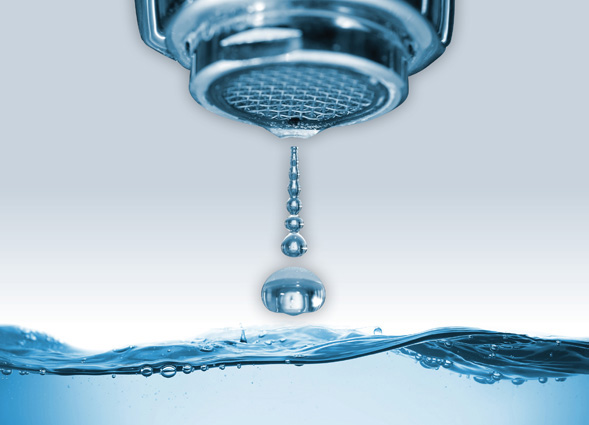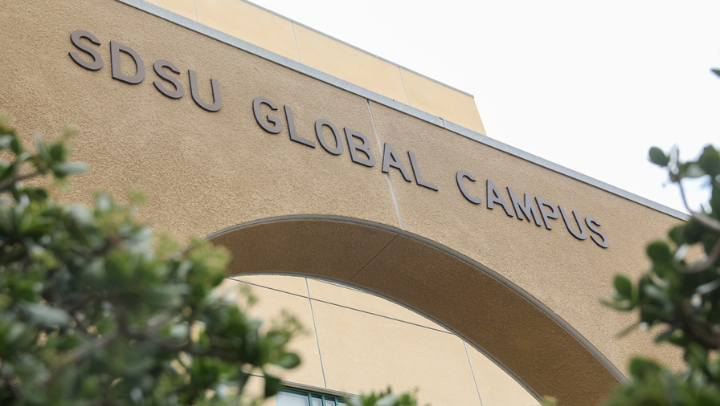Plugging the Leaks
As drought stresses San Diegos water system, the city and SDSU are finding ways to make every drop go further.

“My vision is that San Diego will become a world-recognized hub for water research.”
This story appears in the fall 2015 issue of 360: The Magazine of San Diego State University.
Our experience with water is a disjointed one. Our dishwater comes from the sink tap, our drinking water from the fridge or a bottle, our bathing water from the shower faucet. Farmers draw their water from the canals. We swim in lakes, monitor reservoir levels and try to treat our waste before it’s washed out to sea. Clean, reliable water is critical to our daily lives, yet it flows from so many different sources for such a wide variety of uses that it’s easy to overlook the complex network that links our region’s water sources.
“They are all very interconnected,” said Halla Razak, director of public utilities for the City of San Diego, as well as a civil engineer and a San Diego State alumna.
In times of drought—like the present severe one California has endured for the better part of the last decade—that interconnectedness is magnified. The lack of precipitation throughout the state means Southern California must rely more on importing water to keep its reservoirs at acceptable levels. That means higher prices for consumers. It also costs more for farmers to water their crops, forcing them to raise prices, plant more drought-tolerant crops, or both.
The effects of drought on our water supply ripple outward and under-score the need for new approaches to water conservation, policy overhauls and reuse strategies. At San Diego State University, several researchers are exploring ways to make our parched water supply go a little bit further to help alleviate drought’s stress on the water system.
Don’t just dump it
Every day, the City of San Diego
collects, treats and disposes of about 180 million gallons wastewater. Most of that gets piped out into the ocean and discharged several miles offshore. But is that really the best thing to do with it?
“We spend a lot of money and resources to pipe wastewater into treatment facilities, treat it to high quality, and then just dump it into the ocean—that is quite wasteful,” Razak said.
The City of San Diego currently takes its wastewater treatment a step further: tertiary treatment. Here, further treatment employs filtration and chemical disinfection to remove close to 99 percent of impurities in the remaining water. Voilà, you’ve got water that can be used for irrigation, wetlands discharge, cooling towers, industrial processes and other non-potable uses.
After tertiary treatment, it’s nearly impossible to tell the resulting water came from sewage. “But then people started thinking, ‘If we can treat it even more, we can find more uses for it,’” said Rick Gersberg, professor of environmental health at SDSU and interim director of the School of Public Health.
Pure, potable and plentiful
Enter the City of San Diego’s ambitious Pure Water Reuse Plan. Under this plan, the city would go beyond tertiary treatment of its sewage, introducing processes known as ultra-filtration and advanced oxidation, as well as reverse osmosis through a membrane filter, to turn wastewater into water that’s perfectly safe to drink.
“By the time they do all that, by most parameters of measurement, it’s cleaner than most of the water we drink from the tap,” Gersberg said.
He has worked with colleagues in Singapore to test the water quality of a comparable system presently in place at several wastewater treatment facilities in that country. There, the reclaimed water goes straight into a brand of bottled water called NEWater. When Gersberg spoke to 360, he had a half-empty bottle of it on top of his filing cabinet.
“I’m not an aficionado,” he said, “but I can’t tell the difference.”
Bringing his expertise to San Diego, Gersberg sits on the City of San Diego’s Pure Water Independent Advisory Panel. The city’s reclaimed water wouldn’t go into bottles but instead into the San Vicente Reservoir in East County. Once there, it would feed into the city’s normal potable water supply. Razak figures that for every 100 million gallons of wastewater taken in, the Pure Water treatment system could produce 83 million gallons of potable water. Pure Water’s stated goal is by 2035 to have about a third of San Diego’s tap water come from treated wastewater.
Safe waters
Once the water is in the reservoirs, Gersberg and several other SDSU researchers have another role to play: screening for toxic compounds that might not be caught by conventional treatment methods. Here, the risk isn’t so much from the original reclaimed wastewater itself, but possible toxicity from byproducts of the treatment process, as well as from diverse sources in the environment.
“A lot of things are removed by reverse osmosis, but not everything,” Gersberg said.
He specializes in hunting for pharmaceutical compounds that can slip through treatment procedures. Another active line of research carried out by Gersberg, along with environmental scientist Eunha Hoh of SDSU’s School of Public Health, focuses on how discarded cigarette butts contribute to water toxicity. The end goal is for the water in San Diego’s reservoirs to be as safe as possible when it comes out of the tap, whether it originated from rainwater or was reclaimed from a treatment facility.
SDSU recently announced a new initiative, “Blue Gold: Mitigating the Effects of Water Scarcity,” to delve even deeper into new technologies and approaches to ensure our region has enough clean, safe water to sustain its population and industries. In the coming years, the university will hire a number of public health speciaists, water treatment engineers, geochemists and water-resource geographers to support this effort.
Gersberg sees Blue Gold as an opportunity for SDSU and the San Diego region at large to do globally important work.
“My vision is that San Diego will become a world-recognized hub for water research,” he said.
A world away
On the other side of the world, SDSU environmental engineering professor Natalie Mladenov and a handful of students are experimenting with lower-tech solutions for water reuse. Mladenov leads a National Science Foundation–funded program that gives students an international perspective on water treatment through first-hand work in the impoverished outskirts of Durban, South Africa.
“South Africa’s urban centers are first-world, but its surrounding areas are very poor and there’s a major lack of sanitation infrastructure,” said Mladenov, who is also a core faculty member of SDSU’s Blue Gold initiative.
This past summer, she led the program’s first cohort of students—two undergrads and a grad student from SDSU, plus one professor and two undergrads from California State Polytechnic University, Pomona—as they teamed up with scientists from the University of KwaZulu-Natal to explore the potential of implementing a simple and cheap water treatment system to improve community life. The goal isn’t to produce potable water, but to purify it enough to make it safe to reintroduce to constructed wetlands, where natural environmental processes eventually render it usable for agriculture.
In a tiny community outside Durban, the team has built what’s known as a gravity-driven, multi-chamber anaerobic baffled reactor. In a large underground container, wastewater enters from the top, then flows through a series of chambers separated by seven gradually lowering walls. As each chamber fills up, the water breaches the walls and spills over into the next chamber. The solids and waste settle into the bottoms of the chambers and the water gets progressively purer as it passes through the system. All the while, bacteria break down the organic matter in the waste, further purifying it.
“By the time it gets over the seventh wall, it’s pretty clean,” Mladenov said.
Cost effective
It requires no energy input once the system is built, so it’s incredibly cost effective. And as an added bonus, the methane produced in the reactor can one day be used for energy generation for the community.
As part of an experiment, Mladenov and the students are sampling the waste at different points as it passes through the system to see how the organic matter breaks down over time and under different conditions.
By learning more about this, they hope to be able to improve upon the reactor’s design and find ways to optimize the purity of the output. And it’s not just the residents of South Africa who can benefit from this approach. Mladenov believes there’s a place for this kind of technology closer to home, as well.
“The technology may not be that innovative, but the community-focused approach is,” she said. “In the United States, at a community scale, something like this could be implemented as a decentralized system that produces water for watering lawns, flushing toilets, sustaining community gardens, and other uses.”
Climate change will likely make severe droughts more frequent and persistent in our region, so it’s important to explore everything we can do to get the most out of every drop.
“How well regions deal with climate change will be the difference between regions that will thrive and those that will wither,” Razak said.



